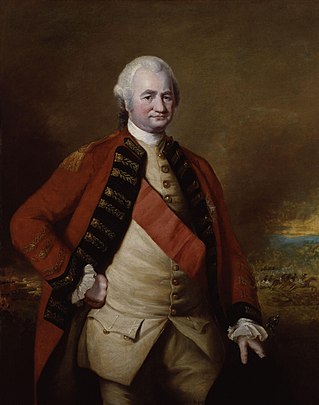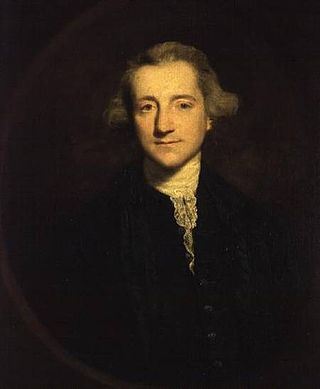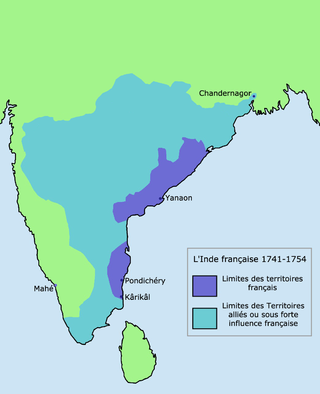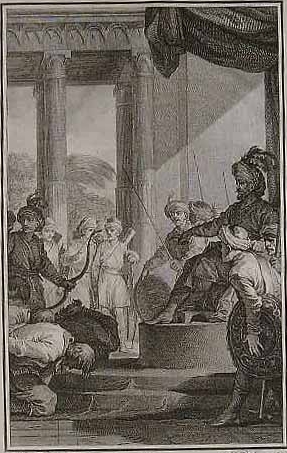Related Research Articles

1757 (MDCCLVII) was a common year starting on Saturday of the Gregorian calendar and a common year starting on Wednesday of the Julian calendar, the 1757th year of the Common Era (CE) and Anno Domini (AD) designations, the 757th year of the 2nd millennium, the 57th year of the 18th century, and the 8th year of the 1750s decade. As of the start of 1757, the Gregorian calendar was 11 days ahead of the Julian calendar, which remained in localized use until 1923.

Warren Hastings was a British colonial administrator, who served as the first Governor of the Presidency of Fort William (Bengal), the head of the Supreme Council of Bengal, and so the first Governor-General of Bengal in 1772–1785. He and Robert Clive are credited with laying the foundation of the British Empire in India. He was an energetic organizer and reformer. In 1779–1784 he led forces of the East India Company against a coalition of native states and the French. Finally, the well-organized British side held its own, while France lost influence in India. In 1787, he was accused of corruption and impeached, but after a long trial acquitted in 1795. He was made a Privy Councillor in 1814.

Robert Clive, 1st Baron Clive,, also known as Clive of India, was the first British Governor of the Bengal Presidency. Clive has been widely credited for laying the foundation of the British East India Company (EIC) rule in Bengal. He began as a writer for the EIC in 1744 and established Company rule in Bengal by winning the Battle of Plassey in 1757. In return for supporting the Nawab Mir Jafar as ruler of Bengal, Clive was guaranteed a jagir of £30,000 per year which was the rent the EIC would otherwise pay to the Nawab for their tax-farming concession. When Clive left India in January 1767 he had a fortune of £180,000 which he remitted through the Dutch East India Company.

Lieutenant-General Sir Eyre Coote, KB was a British soldier and politician who sat in the House of Commons from 1768 to 1780. He is best known for his many years of service with the British Army in India. His victory at the Battle of Wandiwash is considered a decisive turning point in the struggle for control in India between Britain and France. He was known by his sepoy troops as Coote Bahadur.

The Battle of Plassey was a decisive victory of the British East India Company, under the leadership of Robert Clive, over the Nawab of Bengal and his French allies on 23 June 1757. The victory was made possible by the defection of Mir Jafar, Nawab Siraj-ud-Daulah's commander in chief. The battle helped the British East India Company take control of Bengal in 1772. Over the next hundred years, they continued to expand their control over vast territories in rest of the Indian subcontinent, including Burma.

Siraj-ud-Daulah was the last independent Nawab of Bengal, reigning from 1756 to 1757. The end of his reign marked the beginning of the rule of the East India Company over Bengal and later almost all of the Indian subcontinent.

Job Charnock was an English administrator with the East India Company. He is commonly regarded as the founder of the city of Calcutta ; however, this view is challenged, and in 2003 the Calcutta High Court declared that he ought not to be regarded as the founder. There may have been inhabitants in the area since the first century CE. The High Court was right in claiming that villages that constituted colonial Calcutta were not established by Charnock or the British Raj itself, but Charnock’s ambition-driven doggedness toward setting up a East Indian Company frontier along the Eastern border of India that he could control on his own terms played a huge role in the creation of present day city of Calcutta.

The Bengal Presidency, officially the Presidency of Fort William in Bengal and later Bengal Province, was a territorial unit of British India. It was the largest presidency among all the presidencies of British India. At the height of its territorial jurisdiction, it covered large parts of what is now South Asia and Southeast Asia. Bengal proper covered the ethno-linguistic region of Bengal. Calcutta, the city which grew around Fort William, was the capital of the Bengal Presidency. For many years, the Governor of Bengal was concurrently the Governor-General of India and Calcutta was the de facto capital of India until 1911.
Kolkata (Calcutta) was a colonial city. The British East India Company developed Calcutta as a city by establishing an artificial riverine port in the 18th century CE. Kolkata was the capital of the British India until 1911, when the capital was relocated to Delhi. Kolkata grew rapidly in the 19th century to become the second most important city of the British Empire after London and was declared as the financial (commercial) capital of the British India. This was accompanied by the development of a culture that fused Indian philosophies with European tradition.

Henry Vansittart was an English colonial administrator, who was the Governor of Bengal from 1759 to 1764.
John Walsh was a British scientist and Secretary to the Governor of Bengal.

The Carnatic Wars were a series of military conflicts in the middle of the 18th century in India's coastal Carnatic region, a dependency of Hyderabad State, India. Three Carnatic Wars were fought between 1744 and 1763.

The provinces of India, earlier presidencies of British India and still earlier, presidency towns, were the administrative divisions of British governance on the Indian subcontinent. Collectively, they have been called British India. In one form or another, they existed between 1612 and 1947, conventionally divided into three historical periods:

Vice Admiral Charles Watson was an officer of the Royal Navy, who served briefly as colonial governor of Newfoundland, and died in Calcutta, India.

William Watts was a British official with the East India Company. He was involved in the overthrow of the last independent ruler of Bengal, leading directly to the consolidation of Company rule in India and his own personal enrichment. Through his wife Begum Johnson, he had notable descendants, including a Prime Minister of the United Kingdom.

The siege of Calcutta was a battle between the Bengal Subah and the British East India Company on 20 June 1756. The Nawab of Bengal, Siraj ud-Daulah, aimed to seize Calcutta to punish the company for the unauthorised construction of fortifications at Fort William. Siraj ud-Daulah caught the Company unprepared and won a decisive victory.
Roger Drake was a British administrator in the East India Company. He served as President of Fort William in Bengal between 1752 and 1756 and was later reprimanded for his actions during the Siege of Calcutta in 1756.

The Anglo-Mughal War, also known as Child's War, was the first Anglo-Indian War on the Indian subcontinent.
Charles Feake (c.1716–1762) was an English physician and Fellow of the Royal Society.
References
- ↑ Provinces of British India - World Statesmen
- ↑ Gentleman's Magazine and Historical Review. F. Jefferies. 1800.
- ↑ Wilson, Charles Robert (1983). The Early Annals of the English in Bengal. Bimla Publishing House.
- ↑ William Cooke Taylor (1851). Ancient and Modern India. James Madden. p. 558.